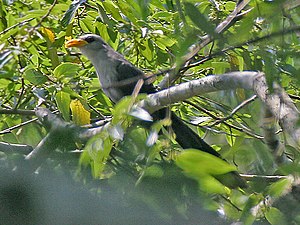Easter cuckoo
| Easter cuckoo | ||||||||||
|---|---|---|---|---|---|---|---|---|---|---|

Easter cuckoo ( Ceuthmochares australis ) |
||||||||||
| Systematics | ||||||||||
|
||||||||||
| Scientific name | ||||||||||
| Ceuthmochares australis | ||||||||||
| Sharpe , 1873 |

The Easter cuckoo ( Ceuthmochares australis ) is a species from the family of cuckoo birds , which belongs to the so-called ore cuckoos . It is a medium-sized cuckoo that occurs exclusively in south-east Africa and is a resident bird in most of its range. It used to be classified as a subspecies of the western cuckoo , but has been classified as a separate species since 2005.
Unlike many species within the cuckoo, the Easter cuckoo is not a brood parasite, but rather raises its offspring itself. The species is classified as not endangered by the IUCN because of its large distribution area.
features
The Easter cuckoo reaches a body length of 33 centimeters. The control springs account for around 21 centimeters. The strong beak measures around 2.5 centimeters.
There is no conspicuous sexual dimorphism : in both males and females, the skull and neck are dark gray with a greenish tinge. The rein, d. H. the region between beak and eyes is greenish gray. The back, the wings and the upper tail-coverts are slate gray with a greenish tinge. The chin and throat are medium gray. The chest is gray, the belly is also gray, but becomes blackish in the region of the under tail-coverts. The long control springs are shiny green.
The iris is red or chestnut brown, in young birds it is brown. The eyelid ring is yellow to greenish yellow in front of the eye and greenish to bluish behind the eye. The strong beak is bright yellow. The legs are black.
The young birds are similar to the adult birds, but are generally duller in color. The throat and chest are brownish in them and the elytra are brownish at the top.
distribution
The Easter cuckoo is an Afrotropic species. The distribution area extends from southwest Ethiopia, northeast Uganda, southern Somalia, east Kenya via Tanzania to the north and east of Zambia, Mozambique, Malawi, south Zimbabwe to the east of the republic South Africa.
The Easter cuckoo is predominantly a resident bird. However, there are indications that this species of cuckoo leaves the coastal regions of Kenya and Tanzania and moves inland between October and April.
habitat
The Easter cuckoo prefers to stay in secondary and gallery forests that are surrounded by other forest types. It is particularly common on the edge of clearings. It is also found in acacia thickets along rivers and dry thorn bushes in Ethiopia. In the Republic of South Africa, it is mainly found in coastal forests.
It can still be found in East Africa at an altitude of 2000 meters. In the south of Malawi, it still breeds at an altitude of 1,300 meters.
Way of life
The Easter cuckoo is a secretly living bird that usually hovers in the thick foliage of tree tops. It finds its food mainly in the tops eight to 30 meters above the ground. It mainly eats caterpillars, including, like many other cuckoos, very hairy caterpillars, which are avoided by most other bird species. It also eats flying termites, beetles, bees, cockroaches, spiders, snails and tree frogs.
Little is known about the reproduction of the Easter cuckoo. It is assumed that Easter cuckoos are monogamous and defend a territory. Brooding Easter cuckoos have been recorded in Tanzania for May, the period July to September as well as November and December. In the south of Africa they breed mainly in October to December. The nest is a loosely assembled platform made of still leafy branches and is located in dense vegetation in a fork of branches two to five meters above the ground. Clutches usually consist of two eggs. The nestlings are fed by both parent birds.
Duration
The Easter cuckoo occurs differently within the large distribution area. It is an extremely rare bird in southwest Ethiopia. In contrast, it is a locally common bird further in the southeast of its range.
literature
- Johannes Erhitzøe, Clive F. Mann, Frederik P. Brammer, Richard A. Fuller: Cuckoos of the World . Christopher Helm, London 2012, ISBN 978-0-7136-6034-0 .
Web links
Single receipts
- ^ Robert B. Payne: The Cuckoos . Oxford University Press 2005. (Bird Families of the World No. 15) ISBN 0198502133 .
- ^ IUCN: Osterzkuckuck , accessed on August 17, 2016
- ↑ a b c d Erhitzøe, Mann, Brammer, Fuller: Cuckoos of the World . P. 233.
- ↑ a b c Erhitzøe, Mann, Brammer, Fuller: Cuckoos of the World . P. 234.